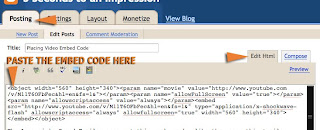 So how does Twitter and Facebook play into this? If you are anything like me, you were probably skeptical. Here comes another technology fad thing.
So how does Twitter and Facebook play into this? If you are anything like me, you were probably skeptical. Here comes another technology fad thing. I also didn't like the name..."Twitter"?, it sounds too cute, kinda girly I thought. Then, I see Oprah, Ellen and Ashton Kutcher using it...okay, definitely not for me. If you're a guy, maybe you can relate. Who needs this stuff?!
But... you can't deny its popularity. Its in the news every day, and so I decided to give it a try especially at the request of some of my students...and ha ha... I like it now, and here are the reasons why, beginning with the ability to increase site traffic...
1) Remember....Once you decide to put ads on your site, you understand that revenue from these ads is based on the amount of clicks your ads receive, which is directly related to the amount of traffic your site gets. If more people visit your site, then the likelihood of someone clicking increases too.
But... you can't deny its popularity. Its in the news every day, and so I decided to give it a try especially at the request of some of my students...and ha ha... I like it now, and here are the reasons why, beginning with the ability to increase site traffic...
1) Remember....Once you decide to put ads on your site, you understand that revenue from these ads is based on the amount of clicks your ads receive, which is directly related to the amount of traffic your site gets. If more people visit your site, then the likelihood of someone clicking increases too.
This is a great thing because from a creative standpoint, it encourages you to constantly update your site/blog, and it also encourages you to maintain high standards for your content. For example, if you are a creative, you will post good animations, well crafted drawings, thoughtful designs, sketches and blogposts.
So here's how you do it, but remember that everybody uses it differently. When you post new content on your site or blog. Simply send out a Twitter feed to let everyone know about it and that's it. If you are consistent in frequency and quality, people will come and visit. I have a group of people who follow my tweets and once in a while, I get new followers who watch for the type of content I post, they get notified (somehow) and they end up following. This is great.
So here's how you do it, but remember that everybody uses it differently. When you post new content on your site or blog. Simply send out a Twitter feed to let everyone know about it and that's it. If you are consistent in frequency and quality, people will come and visit. I have a group of people who follow my tweets and once in a while, I get new followers who watch for the type of content I post, they get notified (somehow) and they end up following. This is great.
The best thing, is that some followers have thousands of followers themselves, if these "whales" like your content, they'll link to you. This is how more and more people visit you and its quite a remarkable way to spread news.
Facebook works in the same way, and if you've been on it for quite a while, you've established a nice friend list comprised of many hundred individuals. Unlike Twitter, these are close colleagues and friends, who would check out the post out of pure interest and because it helps them out. They trust you and therefore are more likely to visit your post.
2) Since joining Twitter, I can't say enough about the inspiration I've received by following certain people, my blogposts have doubled in frequency since joining Twitter. The following tweets are my favorite and since I started following them, I never run out of topics to blog about. By following them, I'm constantly inspired professionally and personally. I used to follow lots of people, but after a while, you begin to filter the "junk". When you get a chance check these people out - its a great way to stay informed - here are my top 3:
Facebook works in the same way, and if you've been on it for quite a while, you've established a nice friend list comprised of many hundred individuals. Unlike Twitter, these are close colleagues and friends, who would check out the post out of pure interest and because it helps them out. They trust you and therefore are more likely to visit your post.
2) Since joining Twitter, I can't say enough about the inspiration I've received by following certain people, my blogposts have doubled in frequency since joining Twitter. The following tweets are my favorite and since I started following them, I never run out of topics to blog about. By following them, I'm constantly inspired professionally and personally. I used to follow lots of people, but after a while, you begin to filter the "junk". When you get a chance check these people out - its a great way to stay informed - here are my top 3:
- http://twitter.com/3dm3
They post nice links to animation, featurettes, and video games all the time. - http://twitter.com/StrategyThought
Very thoughtful tweets on thinking strategically (about your profession and life). - http://twitter.com/AnimationMentor
A must have for every animation student.













